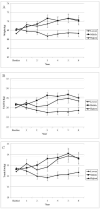Resistance training predicts 6-yr body composition change in postmenopausal women
- PMID: 20019638
- PMCID: PMC2892016
- DOI: 10.1249/MSS.0b013e3181ca8115
Resistance training predicts 6-yr body composition change in postmenopausal women
Abstract
Purpose: The aim of this study was to examine the association of exercise frequency (ExFreq) and volume (total weight lifted by military press and squats (SQ)) with change in body composition among postmenopausal women participating in a progressive resistance training study.
Methods: Previously, sedentary women (n = 122, age = 56.3 +/- 4.3 yr) were followed for 6 yr. At 6 yr, there were women who had been randomly assigned to resistance training at baseline (n = 65) controls that were permitted to cross over to the exercise program at 1 yr (n = 32) and 25 true controls. Exercisers and crossovers directed to perform eight core exercises for two sets of eight repetitions at 70%-80% of one-repetition maximum, three times weekly, plus progressive weight bearing, stretching, and balance. Body weight and fat were measured at baseline and annually using anthropometry and dual-energy x-ray absorptiometry.
Results: Average change in body weight and total body fat were 0.83 +/- 5.39 and 0.64 +/- 4.95 kg at 6 yr, respectively. In multiple linear regression, ExFreq, military press, and SQ were significantly inversely associated with change in body weight (standardized beta coefficient (SBC) = -0.22 to -0.28, P < 0.01), fat (SBC = -0.25 to -0.33, P < 0.01), and trunk fat (SBC = -0.20 to -0.31, P < 0.03) after adjusting for age, years on hormone therapy, change in lean soft tissue, baseline body composition, and baseline habitual exercise. The lowest tertile of SQ (equivalent to 2.5% attendance) demonstrated significant gain in weight, fat, and trunk fat over 6 yr (P < 0.004), whereas the highest tertile SQ (equivalent to 64% attendance) was able to maintain their weight, total, and regional fat.
Conclusions: We conclude that resistance training is a viable long-term method to prevent weight gain and deleterious changes in body composition in postmenopausal women.
Figures

Similar articles
-
Exercise frequency and calcium intake predict 4-year bone changes in postmenopausal women.Osteoporos Int. 2005 Dec;16(12):2129-41. doi: 10.1007/s00198-005-2014-1. Epub 2005 Nov 10. Osteoporos Int. 2005. PMID: 16283062 Clinical Trial.
-
Weight lifted in strength training predicts bone change in postmenopausal women.Med Sci Sports Exerc. 2003 Jan;35(1):10-7. doi: 10.1097/00005768-200301000-00003. Med Sci Sports Exerc. 2003. PMID: 12544629 Clinical Trial.
-
Changes in physical activity and body composition in postmenopausal women over time.Med Sci Sports Exerc. 2013 Aug;45(8):1486-92. doi: 10.1249/MSS.0b013e31828af8bd. Med Sci Sports Exerc. 2013. PMID: 23439422 Free PMC article.
-
Resistance training in postmenopausal women with and without hormone therapy.Med Sci Sports Exerc. 2003 Apr;35(4):555-62. doi: 10.1249/01.MSS.0000058437.17262.11. Med Sci Sports Exerc. 2003. PMID: 12673136 Clinical Trial.
-
Muscle mass gain after resistance training is inversely correlated with trunk adiposity gain in postmenopausal women.J Strength Cond Res. 2012 Aug;26(8):2130-9. doi: 10.1519/JSC.0b013e318239f837. J Strength Cond Res. 2012. PMID: 21986696 Clinical Trial.
Cited by
-
Effects of training attendance on muscle strength of young men after 11 weeks of resistance training.Asian J Sports Med. 2013 Jun;4(2):101-6. doi: 10.5812/asjsm.34489. Epub 2013 Jan 13. Asian J Sports Med. 2013. PMID: 23802051 Free PMC article.
-
Relationship between fat distribution and cardiometabolic risk in Hispanic girls.Am J Hum Biol. 2018 Sep;30(5):e23149. doi: 10.1002/ajhb.23149. Epub 2018 Aug 20. Am J Hum Biol. 2018. PMID: 30129276 Free PMC article.
-
Comparison of direct measures of adiposity with indirect measures for assessing cardiometabolic risk factors in preadolescent girls.Nutr J. 2017 Feb 23;16(1):15. doi: 10.1186/s12937-017-0236-7. Nutr J. 2017. PMID: 28231807 Free PMC article.
-
High genetic risk individuals benefit less from resistance exercise intervention.Int J Obes (Lond). 2015 Sep;39(9):1371-5. doi: 10.1038/ijo.2015.78. Epub 2015 Apr 30. Int J Obes (Lond). 2015. PMID: 25924711 Free PMC article. Clinical Trial.
-
Relative contributions of lean and fat mass to bone strength in young Hispanic and non-Hispanic girls.Bone. 2018 Aug;113:144-150. doi: 10.1016/j.bone.2018.05.023. Epub 2018 May 22. Bone. 2018. PMID: 29800691 Free PMC article.
References
-
- Ainsworth BE, Haskell WL, Whitt MC, et al. Compendium of physical activities: an update of activity codes and MET intensities. Med Sci Sports Exerc. 2000;32(9 Suppl):S498–504. - PubMed
-
- Anderson JW, Konz EC, Frederich RC, Wood CL. Long-term weight-loss maintenance: a meta-analysis of US studies. Am J Clin Nutr. 2001;74(5):579–584. - PubMed
-
- Baumgartner RN. Body composition in healthy aging. Ann N Y Acad Sci. 2000;904:437–448. - PubMed
-
- Binder EF, Yarasheski KE, Steger-May K, et al. Effects of progressive resistance training on body composition in frail older adults: results of a randomized, controlled trial. J Gerontol A Biol Sci Med Sci. 2005;60(11):1425–1431. - PubMed
-
- Blair SN, Haskell WL, Ho P, et al. Assessment of habitual physical activity by a seven-day recall in a community survey and controlled experiments. Am J Epidemiol. 1985;122(5):794–804. - PubMed
Publication types
MeSH terms
Grants and funding
LinkOut - more resources
Full Text Sources

